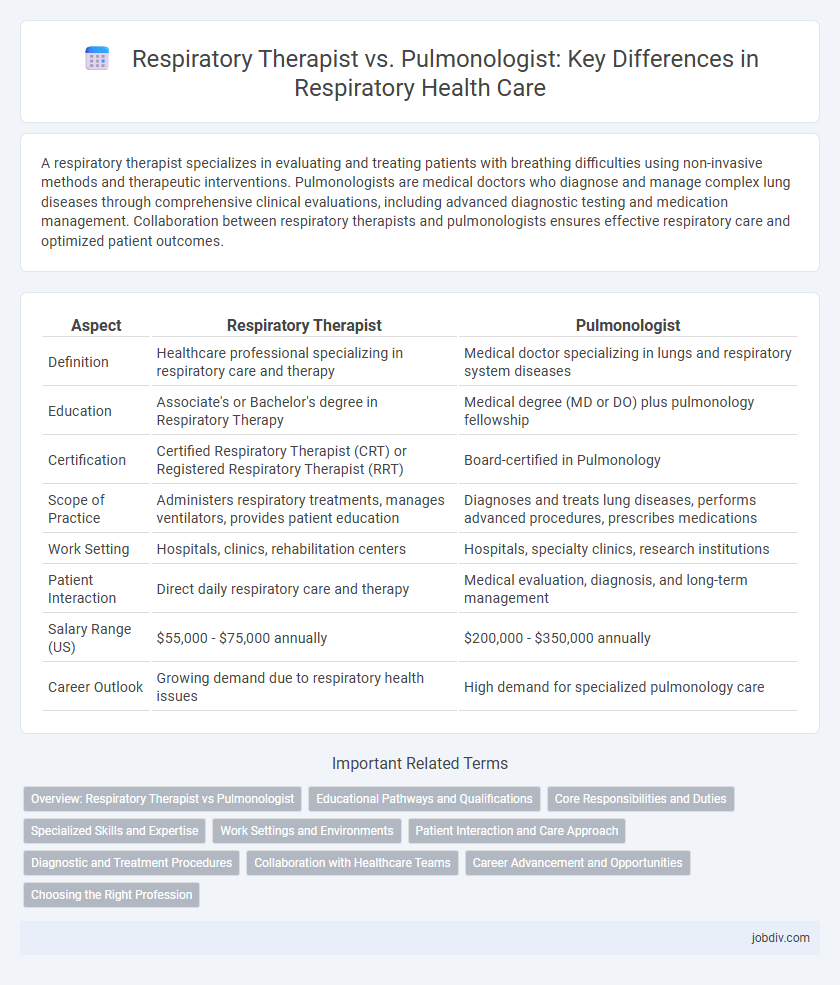A respiratory therapist specializes in evaluating and treating patients with breathing difficulties using non-invasive methods and therapeutic interventions. Pulmonologists are medical doctors who diagnose and manage complex lung diseases through comprehensive clinical evaluations, including advanced diagnostic testing and medication management. Collaboration between respiratory therapists and pulmonologists ensures effective respiratory care and optimized patient outcomes.
Table of Comparison
| Aspect | Respiratory Therapist | Pulmonologist |
|---|---|---|
| Definition | Healthcare professional specializing in respiratory care and therapy | Medical doctor specializing in lungs and respiratory system diseases |
| Education | Associate's or Bachelor's degree in Respiratory Therapy | Medical degree (MD or DO) plus pulmonology fellowship |
| Certification | Certified Respiratory Therapist (CRT) or Registered Respiratory Therapist (RRT) | Board-certified in Pulmonology |
| Scope of Practice | Administers respiratory treatments, manages ventilators, provides patient education | Diagnoses and treats lung diseases, performs advanced procedures, prescribes medications |
| Work Setting | Hospitals, clinics, rehabilitation centers | Hospitals, specialty clinics, research institutions |
| Patient Interaction | Direct daily respiratory care and therapy | Medical evaluation, diagnosis, and long-term management |
| Salary Range (US) | $55,000 - $75,000 annually | $200,000 - $350,000 annually |
| Career Outlook | Growing demand due to respiratory health issues | High demand for specialized pulmonology care |
Overview: Respiratory Therapist vs Pulmonologist
Respiratory therapists specialize in evaluating, treating, and caring for patients with breathing disorders, often operating under pulmonologists' guidance in clinical settings. Pulmonologists are medical doctors who diagnose and treat complex respiratory diseases, perform advanced procedures like bronchoscopy, and manage chronic conditions such as asthma and COPD. Both professions collaborate to improve respiratory health, with therapists providing hands-on care and pulmonologists overseeing medical treatment plans.
Educational Pathways and Qualifications
Respiratory therapists typically complete an associate or bachelor's degree in respiratory therapy, followed by obtaining certification through the National Board for Respiratory Care (NBRC). Pulmonologists undergo extensive education, including a medical degree (MD or DO), completion of a residency in internal medicine, and a fellowship specializing in pulmonary disease and critical care medicine. Licensing requirements for pulmonologists include passing the United States Medical Licensing Examination (USMLE) and board certification by the American Board of Internal Medicine (ABIM) in pulmonary disease.
Core Responsibilities and Duties
Respiratory therapists specialize in administering respiratory care treatments, managing ventilators, and performing diagnostic tests such as spirometry to support patients with breathing difficulties. Pulmonologists diagnose and treat complex lung diseases, interpret advanced imaging, and develop comprehensive treatment plans including medication management and invasive procedures like bronchoscopy. Both professionals collaborate closely to optimize respiratory function and improve patient outcomes in conditions like asthma, COPD, and pneumonia.
Specialized Skills and Expertise
Respiratory therapists possess specialized skills in managing ventilators, delivering breathing treatments, and performing pulmonary function tests, making them experts in day-to-day respiratory care and emergency support. Pulmonologists offer advanced expertise in diagnosing and treating complex lung diseases, including chronic obstructive pulmonary disease (COPD), asthma, and interstitial lung disease, through comprehensive evaluations and personalized treatment plans. Both professionals collaborate closely, with respiratory therapists implementing therapeutic interventions prescribed by pulmonologists to optimize patient respiratory health.
Work Settings and Environments
Respiratory therapists commonly work in hospitals, intensive care units, and rehabilitation centers, providing direct patient care through airway management and pulmonary treatments. Pulmonologists primarily practice in hospital settings, outpatient clinics, and specialized respiratory centers, focusing on diagnosing and treating chronic lung diseases and complex respiratory conditions. Both professionals collaborate in critical care environments, but pulmonologists often engage in clinical consultations and advanced procedures beyond the scope of respiratory therapy.
Patient Interaction and Care Approach
Respiratory therapists provide hands-on, daily care by assessing lung function, managing ventilators, and educating patients on breathing techniques to improve respiratory health. Pulmonologists diagnose and treat complex lung diseases, developing long-term treatment plans and coordinating care for chronic conditions like COPD or asthma. Both professionals collaborate closely with patients, but respiratory therapists focus more on practical management while pulmonologists handle specialized medical decision-making.
Diagnostic and Treatment Procedures
Respiratory therapists perform diagnostic procedures such as spirometry, peak flow measurement, and arterial blood gas analysis to assess lung function and manage ventilator support. Pulmonologists specialize in diagnosing and treating complex respiratory conditions using bronchoscopy, thoracentesis, and advanced imaging alongside prescribing medications and overseeing long-term management of diseases like COPD and asthma. Collaborative care between respiratory therapists and pulmonologists ensures comprehensive evaluation and personalized treatment plans for respiratory patients.
Collaboration with Healthcare Teams
Respiratory therapists and pulmonologists collaborate closely to deliver comprehensive respiratory care by combining specialized skills in diagnosis, treatment, and patient management. Respiratory therapists implement therapeutic interventions and monitor patient responses, while pulmonologists develop treatment plans and oversee complex medical decisions for respiratory diseases like COPD and asthma. This interdisciplinary partnership enhances patient outcomes through coordinated care protocols and shared clinical expertise in hospital and outpatient settings.
Career Advancement and Opportunities
Respiratory Therapists can advance their careers by obtaining specialized certifications or moving into managerial roles in clinical settings, offering opportunities in critical care units and rehabilitation centers. Pulmonologists have broader career advancement options, including subspecialization in areas like interventional pulmonology or sleep medicine, academic research, and leadership positions in healthcare institutions. Both professions benefit from emerging technologies in respiratory care, but pulmonologists typically command higher salaries and greater autonomy in patient management.
Choosing the Right Profession
Respiratory therapists specialize in providing critical care for patients with acute and chronic breathing disorders, focusing on hands-on treatment such as ventilator management and respiratory therapy techniques. Pulmonologists are medical doctors who diagnose and treat complex respiratory diseases, perform diagnostic tests like bronchoscopy, and manage long-term care for conditions such as asthma, COPD, and lung cancer. Choosing between these professions depends on whether one prefers a clinical, patient-facing role with advanced medical diagnostics or a more technical, therapeutic approach to respiratory care.
Respiratory Therapist vs Pulmonologist Infographic

 jobdiv.com
jobdiv.com